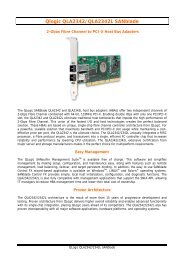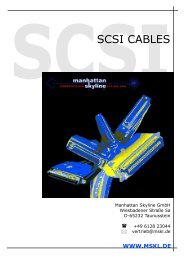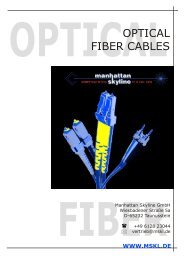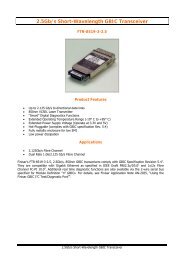Basics of SCSI Fourth Edition - Manhattan Skyline GmbH
Basics of SCSI Fourth Edition - Manhattan Skyline GmbH
Basics of SCSI Fourth Edition - Manhattan Skyline GmbH
Create successful ePaper yourself
Turn your PDF publications into a flip-book with our unique Google optimized e-Paper software.
INTRODUCTION<br />
<strong>SCSI</strong> (pronounced "skuzzy") is an acronym for Small Computer System Interface. <strong>SCSI</strong> originated<br />
from the Selector Channel on IBM-360 computers, and in 1981 was scaled down by the Shugart<br />
Associates Company to make an universal, intelligent disk drive interface. It was called the Shugart<br />
Associates Systems Interface, or SASI, pronounced "sassy". The Small Computer Systems Interface,<br />
or <strong>SCSI</strong>, became an ANSI standard in 1986, after about four years <strong>of</strong> committee discussions.<br />
The word "small" in <strong>SCSI</strong> is just a leftover from the not-so-distant past. <strong>SCSI</strong> is now being used in<br />
computer systems <strong>of</strong> all sizes, from small ones all the way up to big systems.<br />
Before we start talking about <strong>SCSI</strong>, let's define first what a "bus" is, and what kind <strong>of</strong> bus <strong>SCSI</strong> is:<br />
Websters dictionary defines a bus as: "A large motor-driven passenger vehicle operating usually<br />
according to a schedule along a fixed route". In computer applications, a better definition is: "A<br />
conductor or an assembly <strong>of</strong> conductors used for collecting electric currents and distributing them to<br />
outgoing feeders".<br />
This is a very broad definition and we need to clarify the characteristics <strong>of</strong> the <strong>SCSI</strong> bus in order to<br />
understand where and how <strong>SCSI</strong> fits into a computer system. We can classify buses by their<br />
"intelligence" (or lack there<strong>of</strong>), mode <strong>of</strong> operation (serial or parallel), and most importantly we need to<br />
clarify the position <strong>of</strong> the <strong>SCSI</strong> bus in a computer system (backplane bus, peripheral bus, or network<br />
bus). Using these classifications, we can say that <strong>SCSI</strong> is a peripheral bus, that is intelligent, parallel,<br />
with medium-to-high performance. With regard to polarity, <strong>SCSI</strong> using Single-Ended interface is a<br />
"negative" bus (LOW level represents the logical TRUE).<br />
During the course <strong>of</strong> the ANSI committee meetings, the standard was expanded to use devices other<br />
than magnetic disk drives. The standard now recognizes magnetic disk and tape drives, various types<br />
<strong>of</strong> optical disk drives, printers, scanners, processors, communications devices, medium changers,<br />
and other types. The <strong>SCSI</strong> standard has also changed to take advantage <strong>of</strong> newer hardware and<br />
more intelligent controllers. Caching is recognized. Intelligent command queuing is allowed for. There<br />
are provisions for intelligent self-testing by the peripheral. The data path has been widened from 8<br />
bits up to a possible 32 bits. Transfer speeds have risen from a common 1 MHz to a maximum <strong>of</strong> 40<br />
MHz. Work is underway on even higher speeds up to 80 MHz and more.<br />
You may ask "Why would anyone use <strong>SCSI</strong>”<br />
One <strong>of</strong> the possible answers lies in the ease with which new peripheral devices can be added to a<br />
computer system. Without <strong>SCSI</strong>, for each new peripheral you must teach the computer how to<br />
manipulate the hardware to accomplish the reading or writing <strong>of</strong> data to and from the device. In the<br />
past, by the time the hardware and s<strong>of</strong>tware design <strong>of</strong> a computer was complete, a new generation <strong>of</strong><br />
peripherals was <strong>of</strong>ten available which the computer could not use. The development cycle had to start<br />
again. As hardware capabilities grew at increasing rates, it took even longer to develop the<br />
computer-to-peripheral interfaces. As a result <strong>of</strong> all this, the peripherals attached to a computer<br />
system were a generation or more behind the computer itself.<br />
Another good reason for using <strong>SCSI</strong> is the high performance requirements. That is why you will find<br />
<strong>SCSI</strong> used almost exclusively in medium and large systems.<br />
With <strong>SCSI</strong>, the intelligence moved from the host to the peripheral device. The computer now can use<br />
a standard set <strong>of</strong> commands (about a dozen commands for most devices) to accomplish moving data<br />
back and forth to the peripheral. The development cycle for <strong>SCSI</strong> implementations is short. Thanks to<br />
the relative simplicity <strong>of</strong> the <strong>SCSI</strong> interface, it is possible to connect a new peripheral device to an<br />
<strong>Basics</strong> <strong>of</strong> <strong>SCSI</strong> <strong>Fourth</strong> <strong>Edition</strong> 4
















